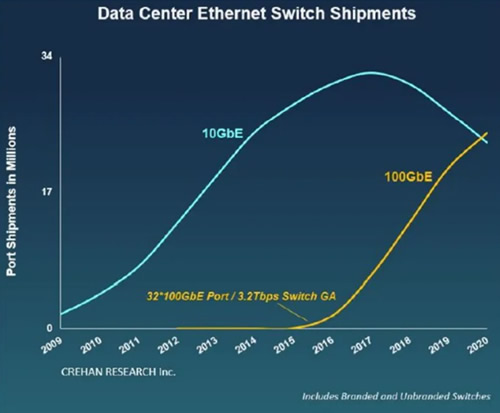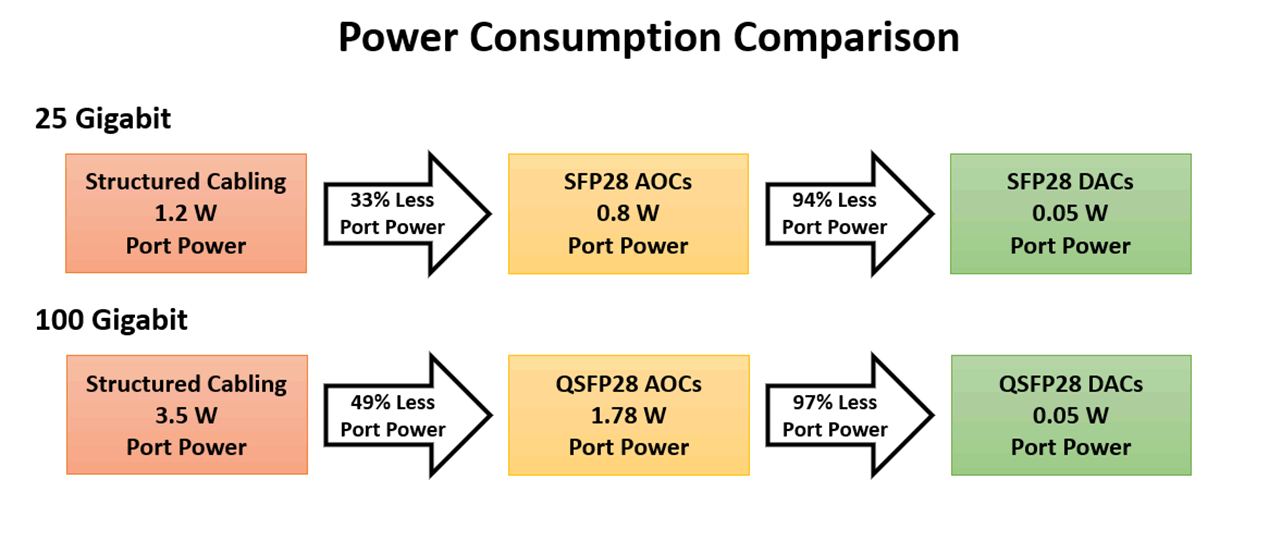Choosing the Right Infrastructure for Your Next Server Migration
Filed under: Data Center
Comments: Comments Off on Choosing the Right Infrastructure for Your Next Server Migration


Server speeds in the data center space have been consistently on the rise over the past decade. To support the increasing amount and size of data for emerging IoT, AI-intensive, and edge-computing applications, cloud data centers are now migrating to 100 Gig downlink connections to servers. In fact, a recent report from Crehan Research Inc. indicates that shipments of 100 Gig switch ports have surpassed 10 Gig in the market.
In the enterprise market, data centers are migrating to 25 Gig server technologies that have become readily available in the market at a price of only 20% more than 10 Gig, offering 2.5 times faster performance over 10 Gig to keep up with digital transformation trends.
Depending on the size and scope of your data center, migrating your server connections to these next-generation speeds is not a question of if, but a question of when. But it’s also a question of how. Do you go with point-to-point connections using Direct Attach Copper Cables (DACs) or Active Optical Cables (AOCs), or do you take a structured cabling approach with transceivers and duplex fiber connectivity? Identifying the right infrastructure for your data center environment can go a long way in easing migration and reducing cost. Let’s take a look at the key considerations.
Distance and Density Scenarios
The first thing data center operators want to look at when choosing infrastructure for switch-to-server connections is the distance they need to support. This often has a lot to do with your overall data center design, such as whether you deploy top-of-rack (ToR) switches in each server cabinet, a middle-of-row (MoR) or end-of-row (EoR) configuration where switches reside in separate cabinet, or a distributed environment where switches reside in a different location altogether.
QSFP28 DACs for 100 Gig and SFP28 DACs for 25 Gig are ideal for ToR deployment where you only need to support short lengths of up to 3 meters within the same cabinet. Depending on your specific application needs, you may also need to consider latency-the amount of time it takes for a bit of data to travel from between the switch and the server. Real-time applications like AI, virtual reality, data analytics, gaming, financial trading, and other emerging technologies require much lower latency. As a pass-through copper cabling solution, DACs up to 3 meters in length used in a ToR configuration offer the lowest latency because they do not require forward error correction (FEC) that adds redundant data to help detect and correct some transmission errors.
For MoR and EoR deployments with slightly longer lengths, you’ll need to do a closer comparison between AOCs and structured cabling based on your specific environment. AOCs can support up to 100 meters but are typically better suited for 10 to 15 meters within a row. Once you get outside of a row, typically beyond 15 meters, AOCs can be difficult to route and manage and structured cabling might be the better choice-especially if dealing with higher densities. If you’re an enterprise data center with 30 or 40 servers housed in a few cabinets and your distances don’t require structure cabling, DACs and AOCs offer the fastest, easiest deployment-simply plug one end into the switch and the other to the server. For data centers that have hundreds or even thousands of server connections outside of the switch cabinet, multi-connection structured cabling can ease management via high-density patching environments.
The Price of Power Consumption
Power consumption is another consideration when it comes to cost. The use of ToR switches with passive DACs offers the lowest power consumption per port. With their embedded transceivers, AOCs consume slightly more power than using DACs. Structured cabling with transceivers are the most power hungry of the three options, typically consuming upwards of 1.2 Watts per port for 25 Gig and 3.5 Watts for 100 Gig. As shown below, when compared to structured cabling for 100 and 25 Gig, AOCs offer 33% and 49% less port power and DACs offer 94% and 97% less port power respectively.

Overall Cost and Availability Impact
As a data center professional, you know that the solution you choose often comes down to price. From an overall material cost perspective, DACs are by far the least expensive option. AOCs with their embedded transceivers carry a higher cost than DACs but are typically still considered a cost-effective alternative to structured cabling. While your distance and density may require structured cabling, the material cost of cabling and separate transceivers makes this option the most expensive. When you then add the cost of power consumption, which includes associated cooling costs, the overall system cost of using AOC and DACs can be anywhere from 30 to 70% lower than structured cabling.
Availability also comes into play. For example, some providers of DACs and AOCs offer limited full meter lengths and no color options, which can be frustrating if you’re trying to reduce slack or need a fast, straightforward way to color code applications. Lead times and labor may also be a consideration, especially if you’re under the gun to bring services online as quickly as possible. Structured fiber cabling assemblies are typically made to order, requiring longer lead times, and installation takes longer than point-to-point DACs and AOCs and requires more space for patching.
Scalability and Interoperability Factors
For data centers that need to grow as they go, scalability is another consideration. Depending on switch port configuration and autonegotiation capabilities, one of the benefits of DACs and AOCs is their ability to support 25 and 100 Gig switch connections with backwards compatibility. For example, SFP28 DACs share the same mating interface as SFP and SFP+ solutions used in 1 and 10 Gig server connections, while QSFP28 DACs share the same interface as QSFP+ solutions used in 40 Gig server connections. This means higher-speed switches can support legacy SFP+ and QSFP+ server connections with DACs or AOCs until server speeds need to be upgraded. Enterprise data centers that use structured cabling have traditionally accomplished 10 Gig server connections via copper twisted-pair cabling (i.e., 10GBASE-T). With 25GBASE-T switch technologies not readily available in the market, migration from 10 to 25 Gig with structured cabling requires a shift from copper to duplex fiber, which requires a complete overhaul of both electronics and cabling infrastructure. However, once deployed, multimode and singlemode duplex fiber structured cabling for the switch-to-switch uplink connections will support both 25 and 100 Gig downlinks to the servers.
You also need interoperability, meaning that the solution you choose should work with any vendor’s switch. Standards-based structured cabling is inherently interoperable with any vendor’s equipment, but when it comes to DACs, some switch vendors will produce a warning message when using third-party cables. Yet DACs from switch vendors are limited in length and color option and are often more expensive, which makes third-party providers an attractive option. A common objection to replacing switch vendor DACs with third-party DACs is warranty and support. However, when there is a failure, switch vendors almost always recommend replacing the DAC as the first step, which is a quick and easy process. It’s important to therefore select third-party DACs from vendors like Siemon that have tested their products to ensure compatibility across equipment from various switch vendors. Siemon also provides samples of their DACs for customers to ensure interoperability before they commit.
Support Always Matters
Last but not least, what good is any option if your vendor doesn’t offer support? The beauty of working with Siemon is not only do we offer proven high-performance SFP28 and QSFP28 DACs in half-meter lengths and multiple color options, as well as AOCs and structured fiber cabling for all flavors of 25 Gig and 100 Gig server deployments, but you also get an expert Data Center Design Services team to help you make the best choice to meet your current and future data center needs. And our dedicated technical sales, product, and engineering professionals ensure you have the options, proven performance, and logistics to get the right solution at the right time.

